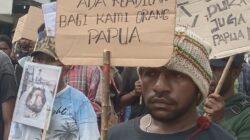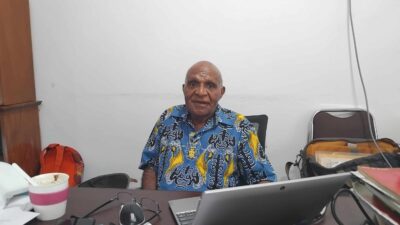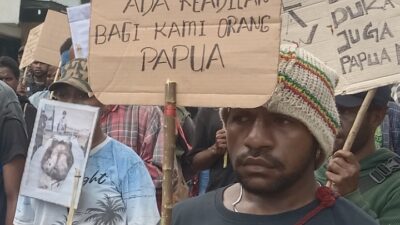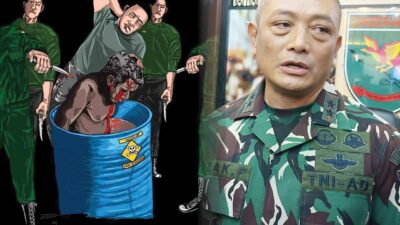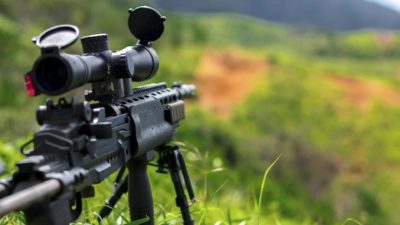This report is a collaborative work of Jubi, Tempo, Suara.com, and Project Multatuli
Jayapura, Jubi – Dozens of youths unfurled banners protesting the arrival of the National Aeronautics and Space Institute/National Research and Innovation Agency (LAPAN/BRIN) team in Saukobye Village, North Biak District, Biak Regency, Papua Province on October 21, 2021.
The youths came from seven villages in the North Biak District, namely Warbon, Saukobye, Korem, Andey, Rosayendi, Mnusfor, and Mambesak.
Aleks Abrauw recounted his participation in the protest when we met him at his parents’ residence in Warbon Village last week.
“We did a blocking against the LAPAN/BRIN team who came without the knowledge of the community as owners of customary rights,” he said.
At that time, Aleks Abrauw and his friends protested for an hour. They demanded LAPAN/BRIN and the Biak Regency Government not to build a satellite launch on the customary land of the Warbon Indigenous People.

Aleks Abrauw is the son of Marthen Abrauw, the tribal chief or mananwir of the Abrauw-Rumander clan. This clan is also known as the Warbon Indigenous People.
Under the tight control of the police and army, the LAPAN/BRIN team with members of the Biak Numfor Legislative Council managed to inspect the land where the satellite launch site was planned to be built. The location is in Saukobye Village.
“We were surprised that suddenly around seven cars came with members of the police and army. Dong (they) came just like a thief while we people know nothing at all,” said Aleks.
The location for the satellite launch belongs to the Warbon Indigenous People, 100-hectare of which is the Warbon Customary Forest that has passed generation over generation.
The people protested because they would lose their customary land if a spaceport was built there. Losing ulayat lands means losing their history and identity.
“The land here is customary land, not LAPAN’s land,” said Aleks.
Welmina Rumadas, who was also present at the protest five months ago, also disagreed with the construction of a spaceport in Saukobye Village. The reason is that this location has always been a place for people to garden for their lives.
“We cultivate this land, we live from keladi (taro), kasbi (cassava), patatas (yam), we don’t eat satellites to live,” said Rumadas who is a resident of Koorem Village.
Welmina Rumadas, Aleks Abrauw, Apollos Mamoribo, and other youths have vigorously advocated against the plan to build a spaceport. They said if the land was handed over, the younger generations of the Warbon Indigenous People would not be able to garden or build houses anymore.
Even though the LAPAN/BRIN project was for the advancement of science, said Welmina Rumadas, the youths disagreed because the location was too close to the village. “If the satellite is to be launched, where will it be and where will the Indigenous Peoples who own the customary lands live?”
“We don’t need satellites, we need to think about the children’s future. The population is getting higher and they need to build houses one day. We will not give up our land even just for an inch because that’s the land of our children. That’s what we thought,” Rumadas said.
According to Rumadas, the government, particularly the Biak Numfor Government, should focus on taking care of children’s education and human resources quality instead of physical development.
“Send the children to school so that there will be human resources who will later carry out the construction, give them the opportunity and let them work on their own land,” said Rumadas.
‘We do not recognize LAPAN land’
In the Abrauw-Rumander Customary Areas Map published by the Biak Numfor Regional Development Planning Agency (BAPPEDA) in 2015, the Warbon customary forest spans an area of 2,142.2 hectares. Of these, 26 hectares have been built for settlements, 41 hectares have been given to the Dimara and Ampnir clans, 56 hectares are owned by LAPAN, 1.2 hectares are used for a high school, 0.4 hectares for the North Biak Police, 0.2 hectares for the North Biak District Office, and 2 hectares for Nermnu Kawaidifu Elementary School.
LAPAN claims to have obtained customary release documents, payment receipts, and land certificates to launch a satellite in the Warbon customary area during the New Order. There were four LAPAN stakes installed in the 100-hectare area but only two stakes are left now as the other two installed on Warbon beach have been lost in the abrasion.
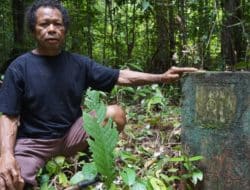
However, Lapan’s claim was not at all recognized by the Warbon Indigenous People. They said they never made a release letter for the land.
Moreover, what will be built is a spaceport. The people are concerned it will impact the surrounding locations, namely their customary forest lands and villages.
“Please build somewhere else. If I own land, I don’t want [a spaceport] to be built on my land cause then I won’t have any land left. How will I, my child, and my grandchildren live?“ said Marthen Abrauw.
He said the government promised welfare to the people but to him, they were just sweet words to deceive the Warbon Indigenous People. He said the government could not guarantee welfare by releasing their customary land.
“I also want welfare for my children and grandchildren. If we, who still have lands, are not living a prosperous life, then what will our children be without the land? It’s not just the land that will be robbed but also our kinship,” he said.
According to Marthen Abrauw, the Biak Numfor Government has never directly spoken to them as ulayat landowners. The district government only conducted dissemination at the district office and invited people who were not landowners.
Even so, he said, the Warbon Indigenous People would never relinquish their customary lands.
“I don’t ever want to. I don’t want anyone to think they have the right to throw me out when I’m working on my land. In sickness and health, I want to live here. People can’t force me out. I own this land, my ancestors lived on this land. This is the last legacy for me and my grandchildren,” he said.
100 hectares are not enough
The Center for Aviation and Space Studies and Policy at LAPAN has reviewed the plan to build a spaceport in Saukobye Village in 2015. The team members are Husni Nasution, Sri Rubiyanti, Bernhard Sianpar, Dini Susanti, Shinta Rahma Diana, and Astri Rafikasari.
The nine-page report describes the opportunities and challenges faced if the construction of a spaceport is carried out in Saukobye Village.
Chances are, the location is geographically very strategic as it is on the seafront facing the Pacific Ocean, which means it has direct access to the sea and transportation. There is also no island, small or large, near or around it.
Meanwhile, the problem is that the 100-hectare land area is not enough for a complete spaceport area. It is estimated that it requires a seven times larger area. In fact, the distance from the current location to settlement areas is less than 1 kilometer and there are already many local residents living around the LAPAN land today.
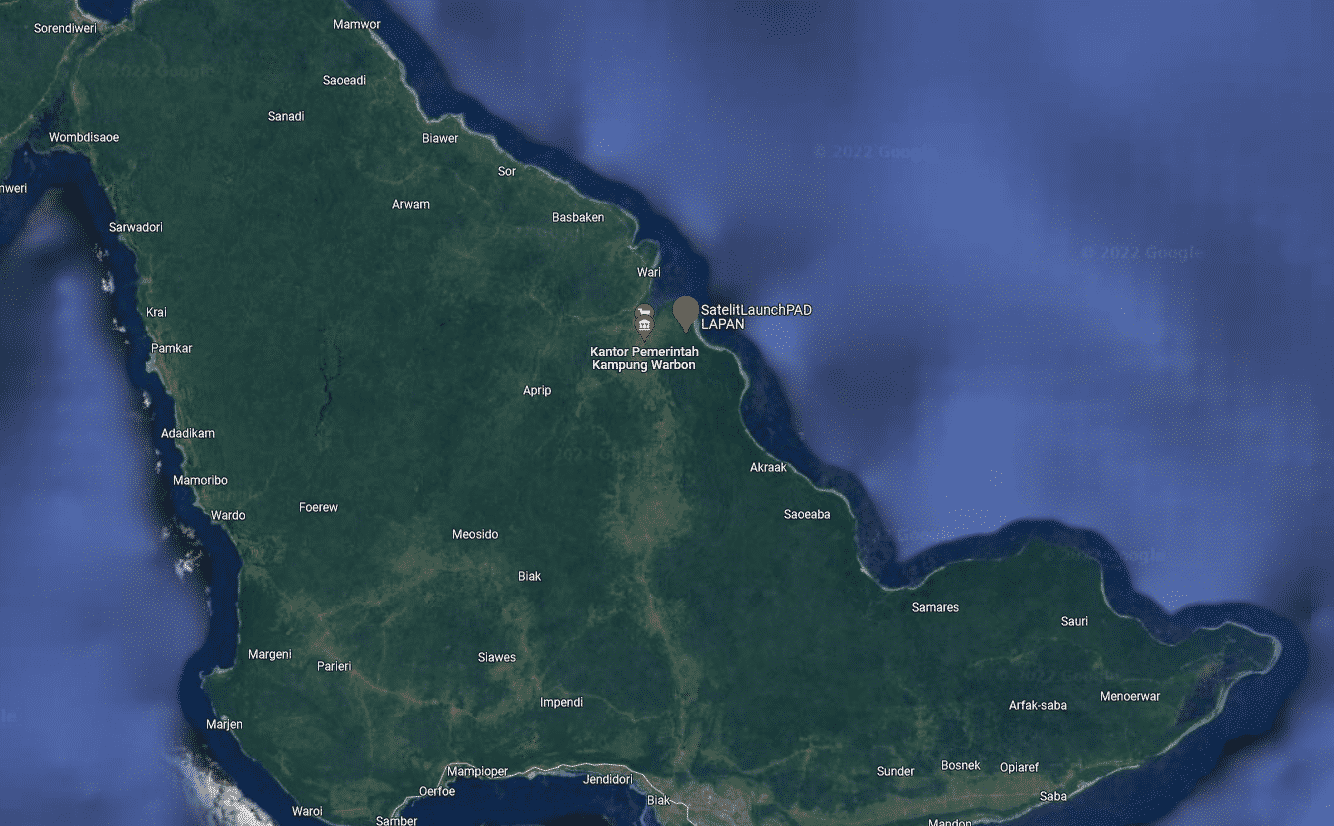
“In fact, for a spaceport area, the distance from a residential area must be at least 5 kilometers from the launch pad. Because it is dangerous, especially if there is an explosion caused by a rocket that is about to be launched,” the report said.
Another obstacle is the uneven or wavy ground that does not meet the criteria for a spaceport. The runway for ship loading and unloading activities is estimated to be only more than 100 meters, which still does not meet the requirements and needs to be expanded.
The location is also quite remote to be reached by land transportation. Another obstacle mentioned is the land claimed by LAPAN in 1980 is currently being protested by the local community.
Head of Saukobye Village Yusup Ampnir expressed his disagreement with the government’s plan to relocate the community. He said it would only cause conflict with other Indigenous Peoples in Biak. Moreover, for the community, the land is a place for them to stand, live, and find food.
“There’s no way we’re moving to someone else’s location. We are afraid that soon there will be a conflict at that location. Apart from my position as village head, when it comes to relocation, I personally disagree,” he said.
He suggested the Biak Numfor Government listen to the voices of the Warbon Indigenous People, the Abrauw-Rumander clans. He said the problem has caused hostility as there were many misunderstandings within the community.
“People are not happy if someone wants to sell land to support the development program. This has brought the families in Saukobye Village and Warbon Village into conflict,” he said.
The spaceport site which is located opposite the Pacific Ocean is also used by the community to go to sea. Elisa Ampnir said she usually catches fish and octopus not only to be consumed but also sold to the market.
She also did not agree with the plan to build a spaceport. If that happens, that means she can no longer go to sea. She is very sure of it. Because the location for fishing is currently very close to the construction site for the spaceport and soon will become a prohibited area for the public.
“Please don’t build here. Where else will we look for fish? This beach is our only livelihood,” said Elisa of Warbon Village.
Intimidation in the release of customary land
The Head of Justice, Peace, and Integrity of Creation (KPKC) of the Evangelical Christian Church (GKI) in Papua Land, Rev. Dora Balubun, told that on April 15, 2018, the KPKC visited Biak after receiving reports from Indigenous Peoples that there were visits by generals to discuss the construction of a spaceport on the land of the Warbon people.
“In 2018 we had a church conference in Sorong. On the last day I was summoned by the head of the synod and was told to visit North Biak. At that time, the head of the synod said I had to go there because the head of the North Biak Classis, Rev. Gerson Abrauw, was threatened. He was about to be beaten because he was not willing to hand over the land,” she said.
Rev. Dora went to check on the condition of the Indigenous People and conducted an interview. From the interview, she found that Indigenous Peoples did not want to give up their land because they did not know where to go. They did not want to lose their identity and ulayat rights and moving to other places would only cause tribal wars with other Indigenous Peoples.
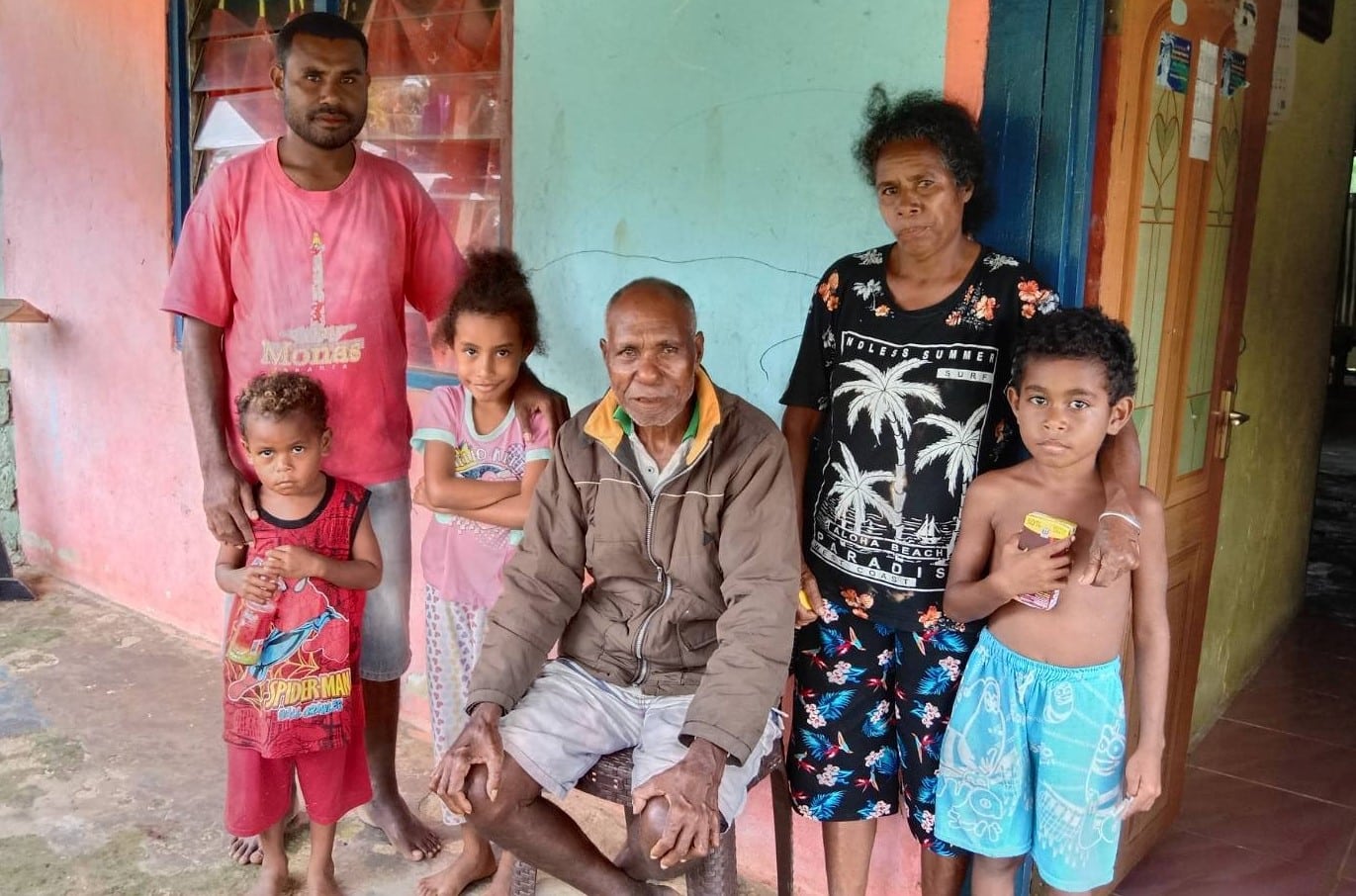
Rev. Dora was told that there was intimidation against Indigenous Peoples that occurred in the 1980s when they refused to give up their land. Those who refused to release their land or attend meetings would be stigmatized as OPM (Free Papua Organization) members.
“In 1982, [North Biak] was still a DOM (Military Operations Area). If the people resisted, they would be labeled as OPM and would definitely be arrested,” Rev. Dora said.
She said that of the many customary land cases handled, coercion and intimidation by the authorities often occurred and turned Indigenous Peoples powerless. Indigenous Peoples sometimes hand over their land to the church to avoid intimidation, as is the case with the indigenous peoples in Kebar, Tambrauw Regency, West Papua.
Based on this finding, Rev. Dora said that the central government, the Papua Provincial Government, and the Biak Numfor Government must facilitate the Indigenous community to decide for themselves.
“The government must be open to discussing what the state wants, then see what is best for them so that no one is harmed,” she said.
Construction of spaceport being reviewed
Field Coordinator of the Biak Satellite Control Center, Space, and Atmospheric Observation, and Remote Sensing Mochmad Luqman Ashari said that according to the LAPAN Medium-Term Development Plan, they should have started building the spaceport this year. The plan mentioned two categories to be built, small-scale and large-scale constructions.

Ashari said that it was certain that a small-scale spaceport would be built first for LAPAN’s experiments or research.
“So the small-scale spaceport will be used by LAPAN itself. That means moving the launch facility that already exists in Pameungpeuk District, West Java to Biak,” he said at the Biak LAPAN Office on Friday, March 4, 2022.
According to Ashari, the satellite launch port on the coast of Cilauteureun Cikelet Pameungpeuk in Garut Regency, West Java must be moved because it is already densely populated and has become a tourist spot recently. It would be dangerous when there was a rocket flight test.
However, Ashari said, the plan to build a spaceport in Biak was currently being reviewed following the merging of LAPAN into BRIN. He received information from the Center for Rocket Technology that LAPANw was currently discussing the government regulation draft for the plan.
“Both the location and the development plan are still being discussed at BRIN. It will be reviewed. Indeed, when it was still LAPAN (not LAPAN/BRIN), the plan has been narrowed down to Biak,” he said.
He then cited Space Law No. 21/2013, which said that Indonesia should have its own spaceport when its space technology is advanced. “Usually we (LAPAN) used India’s,” he said.
According to Ashari, previously there were several choices of locations eyed for the project, namely Enggano Island in Bengkulu Province, Morotai in Maluku Province, and Biak in Papua Province. But Biak is finally chosen because it is geographically very strategic, the distance to the equator is closer so that when launching a Satellite Launching Rocket to Geostationary Earth Orbit, it reaches orbit faster. Closer distance means saving fuel.
Regarding the rejection from the indigenous people, Ashari claimed the 100-hectare land has a land release letter and a payment receipt. He said LAPAN bought the land in 1982 at Rp 50 million for land acquisition, crop replacement, and paving roads.
According to Ashari, the spaceport had not been built to date because it still required Environmental Impact Analysis (AMDAL) and feasibility tests, and LAPAN/BRIN needed to settle the land dispute with Indigenous Peoples.
He said his party disseminated the spaceport project to the Indigenous People three times a year. He also admitted there is no AMDAL for the construction yet.
Head of the National Research and Innovation (BRIN) Tri Handoko said the construction of a spaceport in Biak had not yet been determined because it still had to be discussed with many parties before making a final decision.
“We haven’t decided yet. There are several candidate locations including North Biak and Morotai,” he said.
However, Handoko said that there were already 100 hectares of land belonging to the government in Biak.
“We don’t need to acquire the land in Biak as we have chosen the location where there is no customary land there, only state land,” he said.
According to Handoko, resistance from the resident was normal. However, he claimed that the traditional leaders of all tribes had come to meet and requested that the spaceport be built in North Biak.
“How come someone claims a certain land when there was not yet land determination and boundary? Rejection is normal but we adhere to the customary structure and customary leaders of their tribes,” he said.
Handoko said that customary land was basically state land. “Traditional leaders from all tribes have come to me, they requested that the spaceport be built in North Biak, and they fully support it instead of rejecting it,” he claimed. (*)





